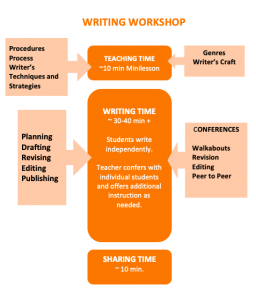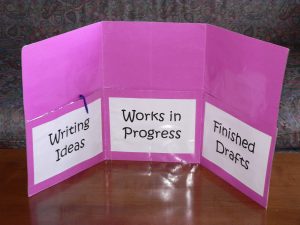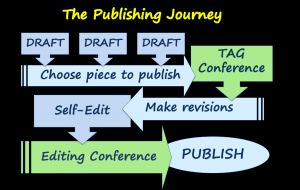WRITING WORKSHOP: WHY BOTHER?
Here’s what we know for sure:
-
Writing is the very best tool we have for supporting comprehension and retention of information.
-
A focus on writing improves performance in every subject area.
-
Written communication is a life skill beyond school in almost every career path. Employers report that issues with their employees’ written skills are not about spelling and conventions; their issues are with clarity of expression.
-
Our students can’t write to learn effectively if they don’t have opportunities to learn to write.
W HAT MAKES WRITING WORKSHOP WORK?
HAT MAKES WRITING WORKSHOP WORK?
WRITING WORKSHOP is a student-centred approach to writing instruction that focuses on ownership and independence. Students decide what they’re going to write, what form their writing is going to take and what they are going to publish. Rather than “assigning” writing tasks, teachers focus on teaching writing strategies and craft, which students are expected to apply in their independent writing.
3 IMPORTANT REASONS TO IMPLEMENT A WRITING WORKSHOP:
1. It meets all students where they are and provides the time and support to stretch them to new levels – the ultimate differentiation tool.
2. With effective routines in place, Writing Workshop might be the best (and easiest) classroom structure for fostering student independence and self-regulation.
3. When students work independently, it frees the teacher up to teach and confer rather than manage.
WHAT DOES WRITING WORKSHOP LOOK LIKE?
A writing workshop classroom often looks like a hive of activity, with some students writing independently, some conferring with partners, some receiving additional teacher support, and some doing some reading research. Although workshops may look quite different in different classrooms, there are 3 common elements:
- TEACHING TIME: Brief sessions of explicit instruction and guided practice.
- WRITING TIME: The longest and most important chunk of the writing workshop, this is the time when students work on their own writing.
- SHARING TIME: An opportunity to celebrate and compliment fellow writers, to ask questions and sometimes give advice.
HOW WRITING WORKSHOP BUILDS INDEPENDENCE

You’re never done writing until writing time is done.
This “golden rule” of writing workshop establishes the expectation that students will be responsible for planning and using their own time. What a treat for teachers to never hear those dreaded words, “What do I do when I’m done?” Start with three options for students who “finish” what they’re working on:
- Start a piece
- Finish a piece
- Revise a piece
Of course, like any routine, this doesn’t happen overnight, even with older students. Each option may require modelling and guided practice before students can be expected to apply them independently. This essential “never done” routine not only honors the different developmental stages of every student, it frees the teacher up to confer and actually teach.
1. Self-selection of topics
Students have plenty of opportunities to learn to write to a prompt in other subject areas; writing workshop is a time for them to write about what matters to them. However, we don’t want students wasting writing time because they can’t think of anything to write about. That’s why topic sheets like the LOVE IT OR LOATHE IT CHART are useful tools to have in their writing folders.
2. Managing Materials
Single side, double space…Revision is easy on a word-processor, but if students have to write with pen and paper, teach them to leave enough space for revising without recopying. Writing on only one side enables writers to cut apart the page to add, change or reorganize information.
 Writing folder Establish routines for paper management right from the start. Check out this three-pocket folder easily made from a sheet of tagboard. The first pocket holds topic lists and planning sheets, the second pocket stores incomplete pieces of writing, and the third pocket contains completed drafts, ready to take to publication. In The Publication Journey described below, students only keep three pieces in their folders at any time.
Writing folder Establish routines for paper management right from the start. Check out this three-pocket folder easily made from a sheet of tagboard. The first pocket holds topic lists and planning sheets, the second pocket stores incomplete pieces of writing, and the third pocket contains completed drafts, ready to take to publication. In The Publication Journey described below, students only keep three pieces in their folders at any time.
3. Managing Time
Because every student will be at a different stage of the writing process at any given time, they must learn to orchestrate their own writing time. In a single writing period, they might make some revisions to an existing draft, do some research for an upcoming project and have a peer conference with a friend. A WRITING LOG helps students plan their writing time and record what they accomplished during that time, also a useful assessment tool for teachers.
4. Peer-to-Peer Talk
The teacher isn’t the only one who can offer ideas and advice to other writers. In fact, for many people, writing is a social activity. Establish consistent routines for partner talk and teach students to TAG each other – Tell something you like, Ask questions, Give advice.
5. Publishing 
Writers revise and edit (“polish to publish”) their best pieces of writing to share with an audience. Not everything will – or should – go to publication. In HIP Education Director Lori Jamison’s book Marvelous Minilessons for Teaching Intermediate Writing, she suggests that students publish one out of every three pieces they write. Read more about the “Publishing Journey” here.
Get more information about how to launch a writing workshop for maximum student independence (and minimum teacher intervention) as well as plenty of practical mini lesson ideas in HIP Education Director Lori Jamison Rog’s newest book, Marvelous Minilessons for Teaching Intermediate Writing, available in Canada from Pembroke and in the USA from Stenhouse.
Click here to read Lori’s Tips for Making Writing Workshop Work.

